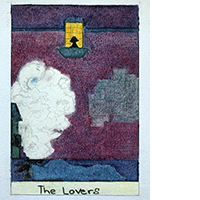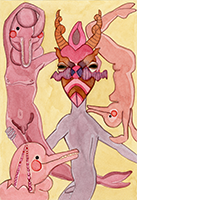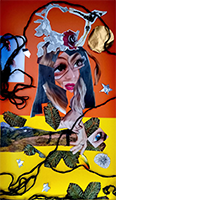Letter from the Editors
Our world is filled with erotic energy.
The word erotic is loaded and, at best, ambiguous; yet, for most of us, it’s also excitatory. It elicits
sensations, memories, fantasies, an entire world that is most often submerged below the surface of our
everyday selves. But what, exactly, is erotic and what does it mean to publish a magazine dedicated to
the erotic in arts and literature?
Perhaps in contemplating the erotic, we should gaze backwards toward ancient Greece where the
concept was borne from the flutter of Eros’s wings. The word erotic comes from the Greek myth of Eros.
Eros, once a primordial force within the universe and then, in later myths, the offspring of Aphrodite and
Ares, Eros came to represent those forces of love and fertility. In part, the early myths have endured and
even transmutated from culture to culture because they capture the complexity of the human experience and distill it into simple archetypes and stories. Eros is no different. Though Eros’s origins evolved over time, he has remained a force active in the lives of all of us, igniting within us our own carnality and desire.
With this in mind, I like to think of Eros as the seat of our soul from which the most primal and sexual
parts of our natures emerge. The erotic, then, is the form in which our carnality takes shape.
When contemplating the themes of Pink Disco, I thought hard about what it means to feel that energy.
On the one hand, we could easily look at what has become commodified as sex in our society and point
to that as erotic. To some extent, this works. But I also firmly believe some of the most potent sex we
encounter is founcd in the sublime and secret whispers of our everyday lives.
Don’t get me wrong. Pink Disco welcomes latex, leather, nipple clamps, and feathers. We want to see your O face. But we also believe the most explicit sex is not an isolated act but the apex of the totality of our experience; it is a celebration of what it means to be human, to have a body, and to experience sensation.
Pink Disco, then, is a celebration of the erotic, our carnality, our bodies, and ultimately our humanness.
Come play with us.
Pink
THE LOVERS
March 19, 2024
Whether or not you believe the tarot to be a divinatory tool, it’s difficult to not see it as a series of seventy-eight highly rich and illustrative images that represent some aspect of human existence. This
is what has made it an enduring game for some and sacred talisman for others. And though many
artists and magicians have taken a stab at recreating and re-rendering its images since its original 15th
century conception, the basic structure has undergone little revision.
The most famous of contemporary decks is inarguably the Smith-Waite deck, produced in the early part of the 20th century and reflective of the pseudo-Christian and hermetic values of the Hermetic Order of the Golden Dawn, of which both Pamela Coleman Smith and A.E. Waite were both members. When most of us recall images of the tarot, it is this deck with its usage of bright primary colors and intuitively-grasped symbolism that we imagine.
For each card, especially the twenty-two major arcana, there is imbedded within its imagery a meaning as well as the inverse of that meaning. For this reason, the tarot can feel to some to be a trickster, obfuscating the obvious. To really get to know the tarot, one must dive below the surface- level meanings and penetrate the depths of our own lived experiences, our own tragedies and euphoric exaltations. We must be as deep-sea divers examining the wreckage and forgotten totems of our past. What is a sea’s surface anyway but an illusion, seemingly solid in its stillness, but containing within its depths the monstrous and mysterious, as well as the threat of danger and death.
For this year’s themes, we have chosen four major arcana cards that we feel represent each of the four seasons, as well as the tempestuous waters of lived experience as we encounter these archetypes in our lives. This issue gives us The Lovers. In the Smith-Waite deck we see two beings in Edenic paradise, fully naked and in celebration of each other and themselves before the archangel Raphael who is crowned in glory by the sun above. Yet, in this card we also see the Tree of Knowledge of Good and Evil, guarded by a serpent. We know this state of unity to be one of temporality, soon to be disrupted by disharmony, strife, and chaos which also breathes life into the cosmos. But such chaos is also necessary for within it lies the seeds of what it means for us to be human. We strive against Edenic stagnation because we see within us greater potentiality.
We also see this striving in the encounters we have with each other, despite the nature of our relationships. And it is through the clash of individual wills, the give and take of self-assertion and sometimes surrender, that the spark of erotic energy is ignited. To be in love with someone or something is to understand your separateness from it and to yearn to be united with it.
Each of the pieces selected for this issue embodies this tension. We feel it in Red Passion’s poem, “Her Hand,” where the incorporeal surface separating spirit from flesh dissolves in an act of fisting. Mish Murphy’s series of flash fiction pieces show us the fragility and temporariness of all encounters. Every single one of these pieces in this issue shows us a different shaft on light elicited from the multi-faceted, prismatic archetype of the lovers.
As always, we really hope you find the work contained herein to be as entertaining and provocative as we did.
You can also find a playlist inspired by the work of our contributors here.
The most famous of contemporary decks is inarguably the Smith-Waite deck, produced in the early part of the 20th century and reflective of the pseudo-Christian and hermetic values of the Hermetic Order of the Golden Dawn, of which both Pamela Coleman Smith and A.E. Waite were both members. When most of us recall images of the tarot, it is this deck with its usage of bright primary colors and intuitively-grasped symbolism that we imagine.
For each card, especially the twenty-two major arcana, there is imbedded within its imagery a meaning as well as the inverse of that meaning. For this reason, the tarot can feel to some to be a trickster, obfuscating the obvious. To really get to know the tarot, one must dive below the surface- level meanings and penetrate the depths of our own lived experiences, our own tragedies and euphoric exaltations. We must be as deep-sea divers examining the wreckage and forgotten totems of our past. What is a sea’s surface anyway but an illusion, seemingly solid in its stillness, but containing within its depths the monstrous and mysterious, as well as the threat of danger and death.
For this year’s themes, we have chosen four major arcana cards that we feel represent each of the four seasons, as well as the tempestuous waters of lived experience as we encounter these archetypes in our lives. This issue gives us The Lovers. In the Smith-Waite deck we see two beings in Edenic paradise, fully naked and in celebration of each other and themselves before the archangel Raphael who is crowned in glory by the sun above. Yet, in this card we also see the Tree of Knowledge of Good and Evil, guarded by a serpent. We know this state of unity to be one of temporality, soon to be disrupted by disharmony, strife, and chaos which also breathes life into the cosmos. But such chaos is also necessary for within it lies the seeds of what it means for us to be human. We strive against Edenic stagnation because we see within us greater potentiality.
We also see this striving in the encounters we have with each other, despite the nature of our relationships. And it is through the clash of individual wills, the give and take of self-assertion and sometimes surrender, that the spark of erotic energy is ignited. To be in love with someone or something is to understand your separateness from it and to yearn to be united with it.
Each of the pieces selected for this issue embodies this tension. We feel it in Red Passion’s poem, “Her Hand,” where the incorporeal surface separating spirit from flesh dissolves in an act of fisting. Mish Murphy’s series of flash fiction pieces show us the fragility and temporariness of all encounters. Every single one of these pieces in this issue shows us a different shaft on light elicited from the multi-faceted, prismatic archetype of the lovers.
As always, we really hope you find the work contained herein to be as entertaining and provocative as we did.
You can also find a playlist inspired by the work of our contributors here.
Visual Art

Vagrants

The Lovers

untitled

Pink
Poetry
To Be Here
Female Faggots
Wheeze
Her Hand
peen
cope
Flash Fiction
Have a Safe Trip
Doppelgänger
It Was Not My Fault
Fiction
The Cherry
Alleyway
Jump

